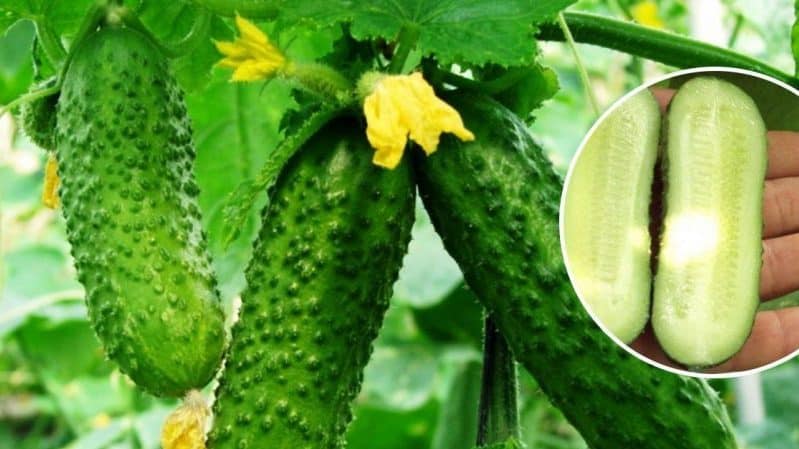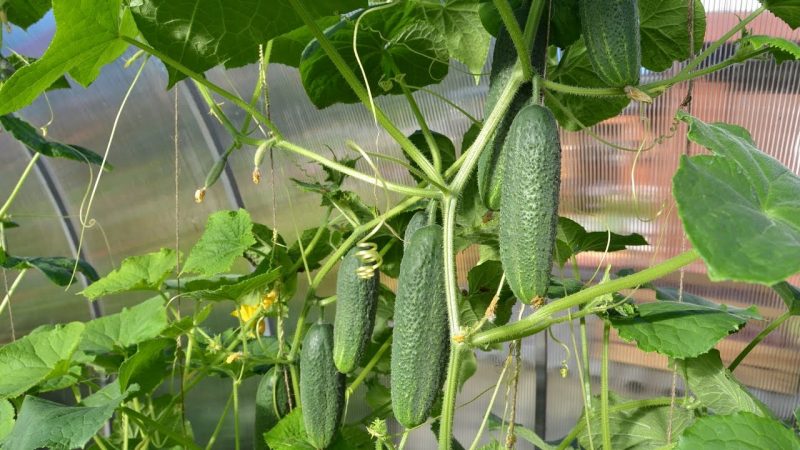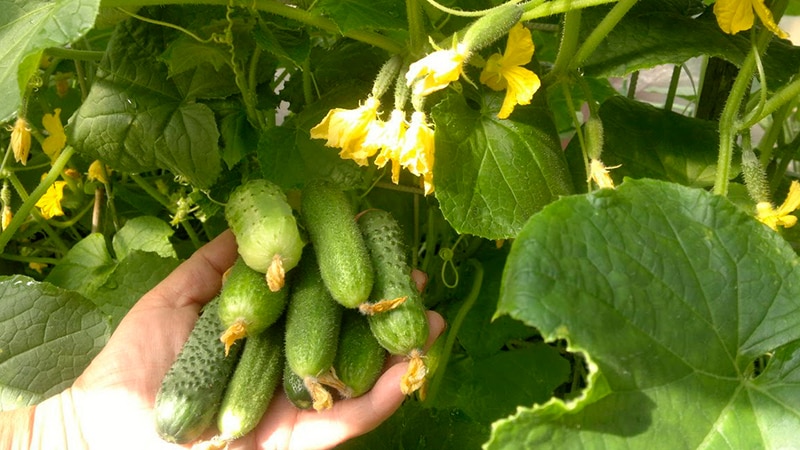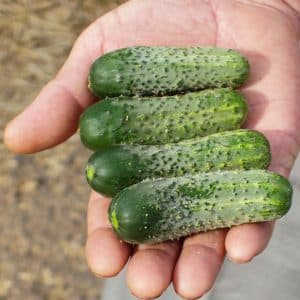What are parthenocarpic cucumbers and which varieties to choose?
Parthenocarpic cucumbers are hybrids with female flowers that can form fruits without pollen. The popularity of such varieties has increased significantly in recent years. In gardening stores, you can increasingly find seed marked as a parthenocarpic variety.
In this article we will talk about the nature of parthenocarpy, give examples describing the most popular varieties and tips for choosing them.
What is parthenocarpy
Parthenocarpy literally means “virgin fruit” in Greek. Fertilization and fruit set occur on female flowers. Male cells do not participate in this process. The seeds of such cucumbers are small or absent altogether.

Previously, farmers had to set up hives of bees in greenhouses to achieve fertilization. But by the end of the twentieth century, breeders managed to obtain varieties that reproduce without pollination.
Reference. The first parthenocarpic cucumbers turned out to be huge, up to 50 cm long. The unusual fruits could not win the love of the consumer, although they had a pleasant taste and recognizable aroma. Later, varieties appeared that produced cucumbers with a familiar appearance, which quickly became popular.
Main features
Parthenocarpics are suitable for planting in open and closed ground. The manufacturer indicates this information on the packaging. For example, there are crops that bear fruit only in greenhouses and are not suitable for planting in unprotected soil. Such plants are extremely unstable to temperature fluctuations.As they grow, cucumbers take on a hook-like shape and become bitter.
Thanks to the constant development of breeding, from time to time varieties appear that are suitable for cultivation in harsh climatic conditions.
Characteristic features of parthenocarpics:
- abundant flowering;
- plant height reaches two meters;
- same size and color;
- lack of bitterness if growing rules are followed;
- wonderful taste;
- versatility in application;
- high shelf life and transportability;
- lack of yellowness.
Advantages and disadvantages
Advantages of parthenocarpic varieties:
- stable harvest;
- possibility of cultivation in any conditions: greenhouses, beds, loggias;
- improved structure and taste, due to the complete or partial absence of seeds;
- fast growth;
- all the greens are equal, as if by choice;
- large and strong shoots;
- bouquet fruiting - several cucumbers are formed simultaneously in the axil;
- high productivity;
- dense planting is acceptable;
- resistance to viral and bacterial diseases.
Flaws:
- it is necessary to remove fast-growing side shoots to ensure rapid fruit set;
- curly branches require garter and strengthening;
- Due to the thin skin, some varieties of parthenocarpics are unsuitable for preservation.

Popular parthenocarpic varieties
There are a huge number of hybrid varieties of cucumbers with female flowers. We will describe the best parthenocarpics that have earned the trust of summer residents and farmers. All hybrid varieties are resistant to bacterial and viral diseases.
Emelya F1
This is a favorite among all-purpose cucumber varieties. It is characterized by high productivity - up to 16 kg/m². The fruits are used for pickling, pickling, and preparing salads. Cucumbers ripen in 39-42 days and reach 15 cm in length.They have an even green color with light stripes. The variety is suitable for growing in beds and in heifers.
Herman F1
An early-ripening universal variety, for open ground and greenhouses. The fruits ripen 40 days from the moment of planting. The yield is high - up to 35 kg can be harvested from one square meter with proper care. Cucumbers have a dense, lumpy skin of a dark green hue, retain freshness for a long time and do not taste bitter. The length of the fruit is 8-10 cm. Suitable for pickling and salads.
Artist F1
An early ripening variety with developed rhizomes and strong branches. Suitable for growing in film greenhouses and in open areas. The first fruits appear after 45 days. Cucumbers are dark green in color with a whitish edge, 9-10 cm long. The flesh is dense and juicy. Productivity is high - up to 9 kg per 1 m². The fruits are good fresh and canned.
Showcase F1
An early-ripening gherkin variety for cultivation on loggias, in covered greenhouses and in the open air. The bushes are low-growing with weak branch formation. Each bunch contains 2-6 ovaries. The fruits are spindle-shaped, oval, with light green stripes, 8-10 cm long. The dense and crispy structure of the fruit makes them suitable for pickling.

Arina F1
High-yielding hybrid for planting in winter greenhouses. It is resistant to frost. The fruits appear 36-45 days from the moment of planting. Up to 6 kg are collected in 1 m². A maximum of two ovaries are formed in the nodes. The fruits are bright green - 15 cm, eaten only fresh; the variety is not suitable for preservation. The skin is shiny, lumpy. To increase yield, side shoots are pinched.
Turkish Gambit F1
Mid-season variety for outdoor and indoor cultivation. The fruits appear 53-65 days after planting.The greens are medium in size - 10-12 cm, very fragrant, not bitter, without internal voids. Suitable for fresh consumption. The variety is not susceptible to drought and temperature fluctuations. From 1 m² you get up to 15 kg.
Carousel F1
An early-ripening gherkin variety for cultivation in open-air beds, in greenhouses and tunnels. The bushes are low-growing, with 3-6 ovaries in bunches. Up to 13 kg are collected from 1 m². Cucumbers are cylindrical, with light stripes and white pubescence. Length – 10-13 cm. The fruits are used for winter preparations and eaten fresh.
Grandma's Secret F1
Hybrid mid-season variety for planting in open soil and greenhouses. The harvest is harvested after 46 days. Zelentsy are not too large - 10-12 cm, green in color with thorns. Suitable for preparing winter preparations and salads. Up to 15 kg are collected from 1 m².
Summer resident F1
An early-ripening hybrid variety for planting in closed and open soil. Begins to bear fruit after 42 days. Productivity is high - up to 13 kg per 1 m². The fruits are oval-shaped, 10-11 cm long, with dark spines. They have a pleasant taste, a pronounced cucumber aroma, and are not bitter. Cucumbers are suitable for winter twists.
Zozulya F1
Early maturing hybrid for open and closed cultivation methods. High yields are collected from plants grown in greenhouses. Zelentsy appear after 48 days. From 1 m² you get up to 20 kg. The fruits are cylindrical with a slight bend. The skin is thin, rich green in color with small tubercles. The taste is pleasant, the aroma is pronounced.
Zelentsy stored in a refrigerated place no longer than five days. Cucumbers are tasty fresh, but are completely unsuitable for canning because they soften too much.
Form F1
Super early ripening cucumber variety for cultivation in the open air and in greenhouses. The harvest begins after 35 days.The greens are short, cylindrical, pimply, 7-8 cm long. The flesh is crisp, not bitter, with a pronounced aroma. The fruits are suitable for harvesting for the winter. One square meter produces up to 16 kg.
Pasamonte F1

An early ripening unpretentious variety. Suitable for planting in open and closed conditions. From 1 m2 you get 12-15 kg. Zelentsy are short - 6-9 cm, light green, pimply, with white spines and light stripes. The taste is pleasant and refreshing. The flesh is crispy and not watery. Cucumbers can be canned.
April F1
A hybrid salad variety, specially bred for greenhouses and balconies. The first harvest appears 45-50 days after planting. Zelentsy are medium-sized - 15-22 cm, with a bumpy surface and longitudinal stripes. If cultivation rules are followed, up to 30 kg of crop can be harvested from one square meter.
Geisha F1
Late hybrid, for open and closed beds. The variety is extremely resistant to waterlogging and frost. Gherkins with a size of 5-6 cm are formed in the ovaries. Zelentsy are distinguished by their high shelf life - they do not wither or turn yellow for more than a month from the moment of harvest. The pulp is dense, the taste is pleasant. The fruits are used for twists for the winter and for seasonal salads.
Read also:
Why do you need to treat cucumbers with brilliant green and how to do it correctly.
Why boric acid is useful for cucumbers and how to use it correctly.
How to fight melon aphids on cucumbers as quickly and effectively as possible.
Recommendations for choosing a variety
When choosing parthenocarpic varieties of cucumbers, pay attention to:
- country of origin;
- purpose of cultivation;
- landing place;
- weather resistance;
- method of using the crop;
- ripening time;
- productivity.
Dutch and domestic varieties are popular in Russia.The seed material is of high quality and has a high level of germination. A distinctive feature of Dutch cucumbers is their medium tuberosity. The most popular varieties: Dolomite F1, Angelina F1, German F1. Russian breeders have developed excellent varieties: Murashka F1, Siberian Garland F1, Kurazh F1.
The most weather-resistant varieties – April F1, Arina F1, Kurazh F1.
High yields are produced: German F1, Zozulya F1, Arina F1, Summer resident F1.
The best early ripening varieties – Masha F1, Emelya F1, Artist F1, Balagan F1, mid-season – April F1, Turkish Gambit F1, late ripening – Geisha F1.
All known parthenocarpics are used for fresh consumption. The following are ideal for canning: Blanca F1, Pasamonte F1, Babushkin Secret F1, Emelya F1.
Most parthenocarpic hybrids are universal: they grow and bear fruit well in different conditions.
Reference. Experienced farmers advise planting several different varieties, with different characteristics, to increase the chances of reaping a solid harvest.
Conclusion
Parthenocarpics are superior to classical varieties in many respects. They are characterized by a long growing season, develop well in greenhouses and open areas, are resistant to bad weather, and bear fruit all summer. The greens are pleasant to the taste, do not taste bitter, have the same size, dense and sweet flesh.